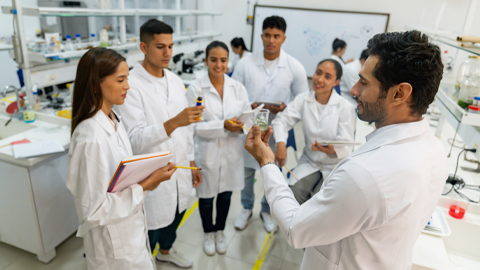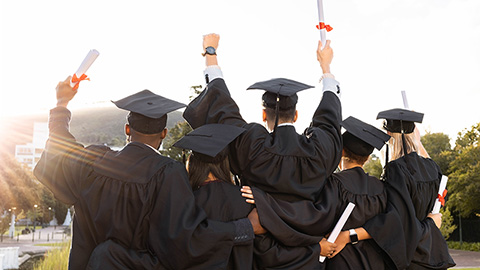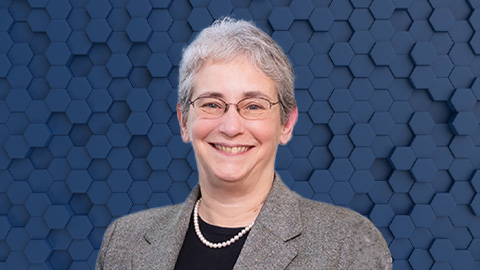
Following my own path
In India, we have a popular saying: “India is a country where people first become engineers and then decide what they want to do in their lives.”
The source is unknown, but these words are relevant to my journey. Due to societal norms and pressures, I became a chemical engineer and then a software engineer. I had no passion for either of these subjects. I had always wanted to study life sciences and English literature.
As an undergrad, while waiting for a Ph.D. offer from the United States, I tried to gain experience in biochemical research at a renowned government institution in India. I was turned down. “You do not have a relevant degree or experience,” I heard from almost every scientist I approached.
Even after coming to the U.S., choosing a suitable lab and mentor was a big challenge. In pursuing a doctoral degree, I knew it was important to choose research that motivated me and a supportive environment. I did not fit into my first lab, so I had to leave and start afresh in my third year. As an international student, I had limited time allocated to finish my degree.

Eventually, I found a supportive mentor and helpful peers. My advisor is an immigrant scientist whose lab is filled with researchers from diverse backgrounds. The supportive atmosphere in our lab helps each of us work in peace, despite the ups and downs we face in our daily lives.
When I met my Ph.D. advisor, Sebastien Poget at the College of Staten Island, City University of New York, I explained that I was interested in his research but did not have a background in biochemistry.

“It doesn’t matter,” he said. “Even I didn’t have one.”
On my first day in the lab, I learned from another graduate student how to transform E. coli cells. That is the level at which I started my doctoral research journey.
In our lab, we probe voltage-gated ion channels and their interactions with animal toxins, mainly, tarantula toxins, using nuclear magnetic resonance. We have seven tarantulas in our lab right now. They look scary, but they generally don’t harm anyone. I even had the privilege of holding one of them in my hand, with the help of the expert who handles them.
A lab transition in grad school is always difficult. Things went well in the beginning, but the pandemic and associated shutdowns did not help me as an experimental researcher in a new field. Our field is very slow-moving, and it takes a long time to publish our research. This has been a big challenge as a researcher with limited time in the U.S. Did I overcome it yet? No, but we as a team, are getting there, and we will, very soon.

The chance to start from scratch doing something I’ve always been passionate about is the perk I associate with interdisciplinary research in the U.S. — something I will always be grateful to this country for. And I will always be grateful to my advisor and friends in my lab who helped me start this journey from scratch.
I have also had fascinating experiences outside my lab in New York City. I am a curious person, in general — both in and out of the lab. I always believed that having the opportunity to live in a cosmopolitan city like New York, I should explore different cultures firsthand.
Through graduate school, I was introduced to “One to World,” an organization that connects international students from around the globe. Through this organization, I got the chance to spend Thanksgiving in Pennsylvania with an American family in 2018, participate in and win a scavenger hunt in the city, go on hikes, participate in painting sessions and have many more experiences. I’ve had the opportunity to meet, interact, and hang out with international students from over 50 nations. We have explored the city and tried out different cuisines. We have talked in detail about our countries and realized our similarities despite our differences — finding unity in diversity.
I have kept in touch with some of the friends I have made over the years. These relationships have made my journey as a scientific researcher in the U.S. fulfilling and given me a strong footing in a place I now can call my second home.

Enjoy reading ASBMB Today?
Become a member to receive the print edition four times a year and the digital edition weekly.
Learn moreGet the latest from ASBMB Today
Enter your email address, and we’ll send you a weekly email with recent articles, interviews and more.
Latest in Opinions
Opinions highlights or most popular articles

Can we make grad school more welcoming for all?
The students and faculty at most of the institutions training the next generation of STEM professionals do not reflect the country’s diversifying demographics, leaving a gap in experience and cultural understanding.

I am not a fake. I am authentically me
Camellia Moses Okpodu explains why she believes the term “imposter syndrome” is inaccurate and should be replaced.

Where do we search for the fundamental stuff of life?
Recent books by Thomas Cech and Sara Imari Walker offer two perspectives on where to look for the basic properties that define living things.

Scientists around the world report millions of new discoveries every year
Science is a collaborative endeavor, and international teams have contributed to a huge rise in scientific output.

Who decides when a grad student graduates?
Ph.D. programs often don’t have a set timeline. Students continue with their research until their thesis is done, which is where variability comes into play.

Redefining ‘what’s possible’ at the annual meeting
The ASBMB Annual Meeting is “a high-impact event — a worthwhile investment for all who are dedicated to advancing the field of biochemistry and molecular biology and their careers.”

